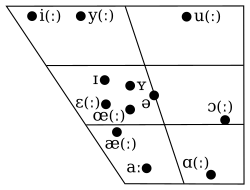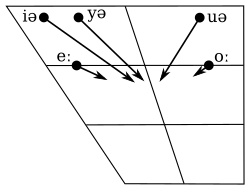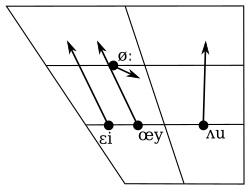Weert dialect
Weert dialect or Weert Limburgish (natively Wieërts, Standard Dutch: Weerts [ʋeːrts]) is the city dialect and variant of Limburgish spoken in the Dutch city of Weert alongside the Dutch language (with which it is not mutually intelligible). All of its speakers are bilingual with standard Dutch.[1]
| Weert dialect | |
|---|---|
| Wieërts | |
| Pronunciation | [βiəʀts] |
| Native to | Netherlands |
| Region | Weert |
Indo-European
| |
| Official status | |
Official language in | Limburg, Netherlands: Recognised as regional language as a variant of Limburgish. |
| Language codes | |
| ISO 639-3 | – |
| Glottolog | None |
It has two varieties: Stadsweerts, spoken in the city centre, and the more rural dialect.[1]
Phonology
Consonants
| Labial | Alveolar | Postalveolar | Dorsal | Glottal | ||
|---|---|---|---|---|---|---|
| Nasal | m | n | (ɲ) | ŋ | ||
| Plosive | voiceless | p | t | (c) | k | |
| voiced | b | d | (ɟ) | ɡ | ||
| Fricative | voiceless | f | s | (ʃ) | x | h |
| voiced | v | z | (ʒ) | ɣ | ||
| trill | ʀ | |||||
| Approximant | β | l | j | |||
- /m, p, b, β/ are bilabial, whereas /f, v/ are labiodental.[1]
- /n, l/ are realized as postalveolar [ɲ, ʎ] when they occur before /c, ɟ/.[3]
- /ɲ, c, ɟ, ʃ, ʒ/ are marginal phonemes.[3]
- /ŋ, k, ɡ, x, ɣ/ are velar, whereas /j/ is palatal.[1]
- /ʀ/ is a voiced fricative trill, either uvular [ʀ̝] or pre-uvular [ʀ̝˖]. The fricative component is particularly audible in the syllable coda, where a partial devoicing to [ʀ̝̊ ~ ʀ̝̊˖] also occurs.[3]
Vowels

| Front | Central | Back | |||||
|---|---|---|---|---|---|---|---|
| unrounded | rounded | ||||||
| short | long | short | long | short | long | ||
| Close | i | iː | y | yː | ə | u | uː |
| Close-mid | ɪ | eː | ʏ | øː | (ʊ) | oː | |
| Mid | ɛ | ɛː | œ | œː | ɔ | ɔː | |
| Open-mid | æ | æː | |||||
| Open | aː | ɑ | ɑː | ||||
- Most of the non-central vowels are more or less centralized, but only /ə/ is phonetically central. The most strongly centralized vowel is /ʏ/, whereas the least strongly centralized vowels are /i, iː/.[5]
- Among back vowels, /u, uː, ʊ, oː, ɔ, ɔː/ are rounded, whereas /ɑ, ɑː/ are unrounded.
- /ʊ/ is used only by older speakers.[6]
- Phonetically, the tense close-mid monophthongs /eː, øː, oː/ are centering diphthongs [ëə, øə, öə],[7] and that is the reason for which they are illustrated on diphthong charts below.
- The first elements of /øː, oː/ are centralized, but are not central enough to be labelled as central.[5]
- The second elements of /eː/ and especially /oː/ are less central ([e̽, ɤ̽], respectively) than it is the case with other centering diphthongs, of which the second element is more like [ə].[5]
- Before nasal consonants, /eː, øː/ are monophthongized to [ɪː, ʏː].[6]
- The /ʏ/-/œ/ and /ɛ/-/æ/ contrasts seem to have begun to collapse.[6]
- /ʏ/ is similar to the schwa /ə/; besides rounding, practically the only difference between those is that /ʏ/ is somewhat more front and slightly higher than /ə/. Phonetically, it can be described as close-mid central rounded [ɵ].[5]
- /ə/ is mid [ə]. It occurs only in unstressed syllables.[8]
- The open-mid front vowels /ɛ, ɛː, œ, œː/ are somewhat higher than open-mid [ɛ̝, ɛ̝ː, œ̝, œ̝ː], but the back open-mid vowels /ɔ, ɔː/ are actually open-mid [ɔ, ɔː].[5]
- /æ, æː/ are best described as somewhat lowered open-mid [ɛ̞, ɛ̞ː].[5]

Part 1 of the Weert dialect diphthongs, from Heijmans & Gussenhoven (1998:110)

Part 2 of the Weert dialect diphthongs, from Heijmans & Gussenhoven (1998:110)
| Starting point | Ending point | |||
|---|---|---|---|---|
| Front | Central | Back | ||
| Front | unrounded | ɛi | iə | |
| rounded | œy | yə | ||
| Back | uə | ʌu | ||
- The rural variety monophthongizes /iə, yə, uə/ to [eː, øː, oː].[1]
- The first elements of /uə, ʌu/ are somewhat centralized ([ü, ʌ̈], respectively), but are not central enough to be labelled as central. Among these, the first element of /œy/ is the most strongly centralized.[5]
- The second elements of /ɛi, œy, ʌu/ are mid-centralized ([ɪ, ʏ, ʊ], respectively).[5]
gollark: http://www.simonjf.com/2018/08/27/cmm-of-wasm.html
gollark: https://github.com/WebAssembly/wabt/tree/main/wasm2c
gollark: I imagine the JITs could be adapted.
gollark: Why not? It's a stack machine.
gollark: You would benefit from highly optimized implentations.
References
- Heijmans & Gussenhoven (1998), p. 107.
- Heijmans & Gussenhoven (1998), pp. 107–108.
- Heijmans & Gussenhoven (1998), p. 108.
- Heijmans & Gussenhoven (1998), pp. 107, 109–110.
- Heijmans & Gussenhoven (1998), p. 110.
- Heijmans & Gussenhoven (1998), p. 109.
- Heijmans & Gussenhoven (1998), pp. 109–110.
- Heijmans & Gussenhoven (1998), pp. 108, 110.
Bibliography
- Heijmans, Linda; Gussenhoven, Carlos (1998), "The Dutch dialect of Weert" (PDF), Journal of the International Phonetic Association, 28: 107–112, doi:10.1017/S0025100300006307
This article is issued from Wikipedia. The text is licensed under Creative Commons - Attribution - Sharealike. Additional terms may apply for the media files.